Related Research Articles
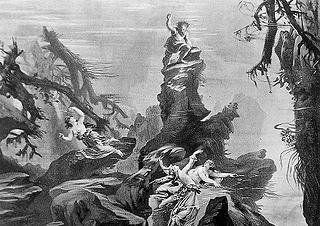
Der Ring des Nibelungen, WWV 86, is a cycle of four German-language epic music dramas composed by Richard Wagner. The works are based loosely on characters from Germanic heroic legend, namely Norse legendary sagas and the Nibelungenlied. The composer termed the cycle a "Bühnenfestspiel", structured in three days preceded by a Vorabend. It is often referred to as the Ring cycle, Wagner's Ring, or simply The Ring.

Das Rheingold, WWV 86A, is the first of the four epic music dramas that constitute Richard Wagner's Der Ring des Nibelungen. It was performed, as a single opera, at the National Theatre Munich on 22 September 1869, and received its first performance as part of the Ring cycle at the Bayreuth Festspielhaus, on 13 August 1876.
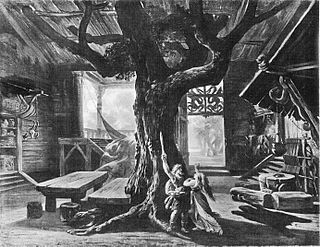
Die Walküre, WWV 86B, is the second of the four epic music dramas that constitute Richard Wagner's Der Ring des Nibelungen. It was performed, as a single opera, at the National Theatre Munich on 26 June 1870, and received its first performance as part of the Ring cycle at the Bayreuth Festspielhaus on 14 August 1876.

Hans Hotter was a German operatic bass-baritone. He stood 6 feet 4 inches (1.93 m) and his appearance was striking. His voice and diction were equally recognisable.

Dame Gwyneth Jones is a Welsh dramatic soprano, widely regarded as one of the greatest Wagnerian sopranos in the second half of the 20th century.
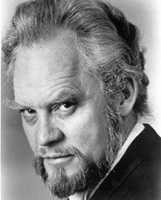
Thomas Stewart was an American bass-baritone who sang an unusually wide range of roles, earning global acclaim particularly for his performances in Wagner's operas.

Bernd Aldenhoff was a German Heldentenor.
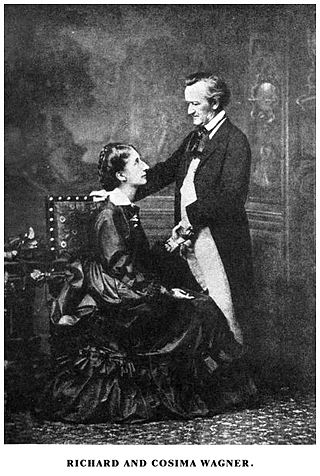
The Bayreuth canon consists of those operas by the German composer Richard Wagner (1813–1883) that have been performed at the Bayreuth Festival. The festival, which is dedicated to the staging of these works, was founded by Wagner in 1876 in the Bavarian town of Bayreuth, and has continued under the directorship of his family since his death. Although it was not originally held annually, it has taken place in July and August every year since the 75th anniversary season in 1951. Its venue is the Bayreuth Festspielhaus, which was built for the first festival. Attendance at the festival is often thought of as a pilgrimage made by Wagner aficionados.
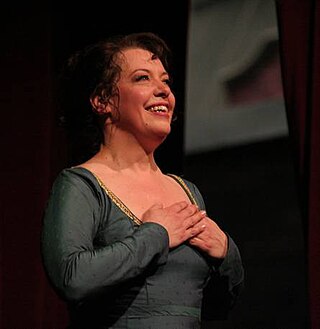
Nina Maria Stemme is a Swedish dramatic soprano opera singer.
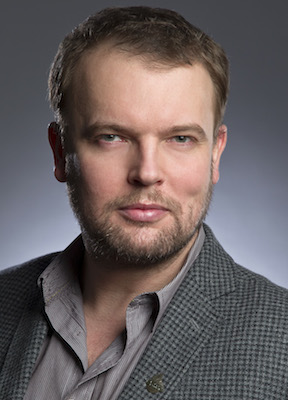
Tomasz Konieczny is a Polish bass-baritone.

Alan Titus is an internationally celebrated baritone.

The Rhinemaidens are the three water-nymphs who appear in Richard Wagner's opera cycle Der Ring des Nibelungen. Their individual names are Woglinde, Wellgunde and Flosshilde (Floßhilde), although they are generally treated as a single entity and they act together accordingly. Of the 34 characters in the Ring cycle, they are the only ones who did not originate in the Old Norse Eddas. Wagner created his Rhinemaidens from other legends and myths, most notably the Nibelungenlied which contains stories involving water sprites (nixies) or mermaids of the Danube.
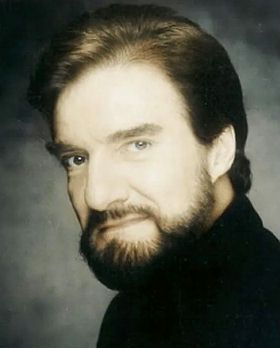
Robert Hale was an American operatic bass-baritone. He was first a leading baritone at the New York City Opera for a decade, where he performed, alongside Beverly Sills, mostly in Mozart operas and in the revival of belcanto opera such as Donizetti's Lucia di Lammermoor.
Ekkehard Wlaschiha was a German operatic baritone who specialized in Wagnerian "villains", such as Alberich, Klingsor and Friedrich von Telramund. He performed at the Bayreuth Festival and at the Metropolitan Opera, and left many recordings.
Johan Reuter is a Danish baritone and opera singer.
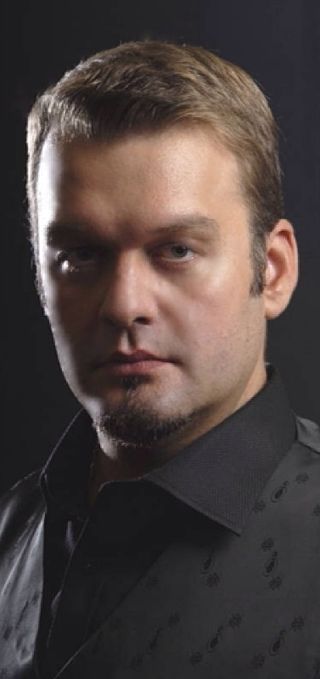
Sorin Coliban is a Romanian opera singer with an international career. His voice range is bass–baritone. He is known for the volume and projection of his voice, both of which help him to sing both bass and baritone roles. He is one of the few singers to have performed with two different voices in the same performance: bass-baritone and countertenor.
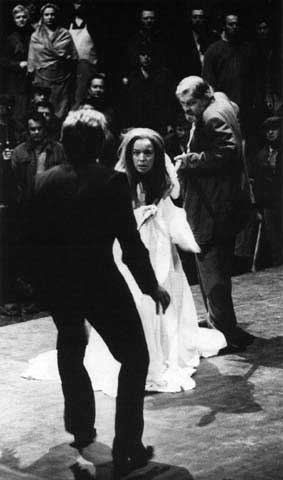
The Jahrhundertring was the production of Richard Wagner's Ring cycle, Der Ring des Nibelungen, at the Bayreuth Festival in 1976, celebrating the centenary of both the festival and the first performance of the complete cycle. The festival was directed by Wolfgang Wagner and the production was created by the French team of conductor Pierre Boulez, stage director Patrice Chéreau, stage designer Richard Peduzzi, costume designer Jacques Schmidt and lighting designer André Diot. The cycle was shown first in 1976, then in the following years until 1980. It was filmed for television in 1979 and 1980. While the first performance caused "a near-riot" for its brash modernity, the staging established a standard, termed Regietheater, for later productions.
Samuel Youn is a South Korean operatic bass baritone.
Joachim Herz was a German Opera director and manager. He learned at the Komische Oper Berlin as an assistant to Walter Felsenstein. His major stations were the Leipzig Opera where he opened the new house with Wagner's Die Meistersinger von Nürnberg, Komische Oper and Semperoper in Dresden, where he opened the restored house with Weber's Der Freischütz in 1985. He staged many world premieres, and worked internationally. Herz was the first director to apply Felsenstein's concepts to Wagner's Der Ring des Nibelungen, staged in Leipzig from 1973 to 1976.
Wilma Schmidt, also known as Wilma Schmidt-Liebethal, was a German operatic soprano. She performed for five decades in leading roles at the Staatsoper Hannover, and appeared as a guest at other opera houses and the Bayreuth Festival. Her broad repertoire included the Countess in Mozart's Figaro, Agathe in Weber's Der Freischütz, Elisabetta in Verdi's Don Carlo alongside Hans-Dieter Bader, Elisabeth in Wagner's Tannhäuser, and her favourite role, the Marschallin in Der Rosenkavalier by Richard Strauss.
References
- ↑ "Flickan från Västern – La fanciulla del west – Kungliga Operan". YouTube (in Swedish).
- ↑ "Flickan från västern på Kungliga Operan" (in Swedish). 31 May 2022.
- ↑ "Vechtscène Eine florentische Tragödie door John Lundgren" – via www.youtube.com.
- 1 2 "Die Walküre".
- 1 2 "Der fliegende Holländer".
- ↑ "John Lundgren — People — Royal Opera House". www.roh.org.uk. Retrieved 2017-11-08.
- ↑ Kungliga Operan (2011-12-15). "Flickan från Västern – La fanciulla del west – Kungliga Operan". YouTube (in German). Retrieved 2018-03-08.
- ↑ "John Lundgren – Dramatic baritone". Artists Management Zurich. Retrieved 2014-02-01.
- ↑ "Puccinis klassiska opera Tosca på Kungliga Operan". app-euwe-operan-prd.azurewebsites.net.
- ↑ "Flickan från västern på Kungliga Operan" (in Swedish). 31 May 2022.
- ↑ Löfvendahl, Bo (18 December 2011). "Flickan från Västern Makalös västernopera". Svenska Dagbladet (in Swedish).
- ↑ "Siegfried – Opera" (in Swedish).
- ↑ "Alberich – Das Rheingold – Bayerischer Staatsoper München".
- ↑ "Alberich – Siegfried – Bayerischer Staatsoper München".
- ↑ "John Lundgren — People — Royal Opera House". www.roh.org.uk.
- ↑ "Das Rheingold – Royal Opera House".
- ↑ "Die Walküre – Royal Opera House".
- ↑ "Siegfried – Royal Opera House".
- ↑ "Aufführungsdatenbank – John Lundgren" (in German).